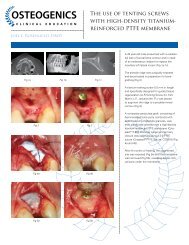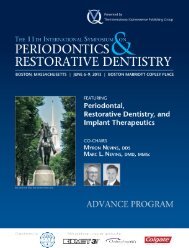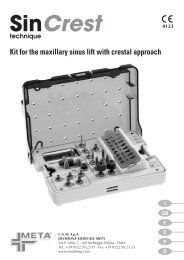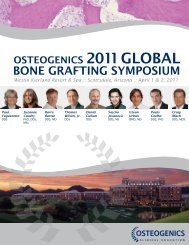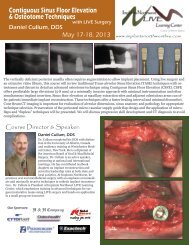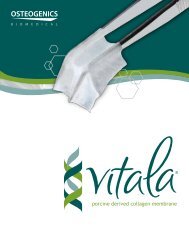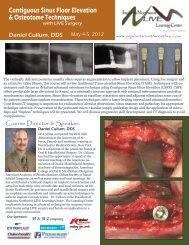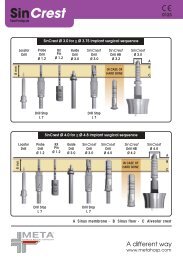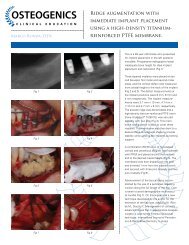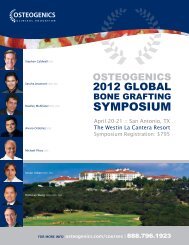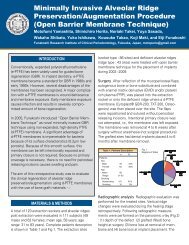Cytoplast™ PTFE Membrane Product Brochure - Osteogenics
Cytoplast™ PTFE Membrane Product Brochure - Osteogenics
Cytoplast™ PTFE Membrane Product Brochure - Osteogenics
Create successful ePaper yourself
Turn your PDF publications into a flip-book with our unique Google optimized e-Paper software.
2 | Why use d<strong>PTFE</strong><br />
Why Use Dense <strong>PTFE</strong> as a <strong>Membrane</strong><br />
<strong>PTFE</strong>: Polytetrafluoroethylene (<strong>PTFE</strong>) is comprised of a carbon chain with two fluorine atoms for every carbon atom. The complete<br />
fluorination of the carbon chain, along with the strength of the carbon-to-fluorine bonds, makes <strong>PTFE</strong> highly stable. This stability results<br />
in a synthetic polymer that is non-resorbable, biologically inert and chemically non-reactive, and therefore an ideal material for many<br />
medical device applications. In addition to its long history in the field of guided tissue regeneration (GTR), <strong>PTFE</strong> has been used for over 30<br />
years in cardiovascular applications such as suture, vascular grafts and heart valves.<br />
Expanded <strong>PTFE</strong>: <strong>PTFE</strong> as a biomaterial differs in porosity based on the amount of expansion applied during manufacturing.<br />
Heating <strong>PTFE</strong> and then applying force expands the material’s microstructure to make expanded <strong>PTFE</strong> (e<strong>PTFE</strong>). Under scanning electron<br />
microscopy, we see a network of dense nodes connected by fibrils. As the nodes and fibrils are expanded, the porosity of the material<br />
continues to increase.<br />
Expanded <strong>PTFE</strong> has a long history of success in GTR procedures, particularly in periodontics. However, the highly porous structure of<br />
e<strong>PTFE</strong> allows ingrowth of bacteria when the membrane is exposed in the mouth. Exposure results in high rates of infection and frequently<br />
requires early removal of the device. In addition, the highly porous structure allows soft tissue ingrowth, which complicates removal, often<br />
requiring sharp dissection and extensive surgery. Expanded <strong>PTFE</strong> must be completely buried and primary closure must be maintained<br />
to ensure predictability. While expanded <strong>PTFE</strong> is useful and quite predictable in deep, buried sites for guided tissue regeneration, there is<br />
currently no role for this material in extraction site grafting where exposure is likely.<br />
Dense <strong>PTFE</strong>: Dense <strong>PTFE</strong>, also known as high-density <strong>PTFE</strong> or d<strong>PTFE</strong>, is manufactured to eliminate expansion of the nodes and fibrils,<br />
resulting in a micro-porous material that is impervious to bacteria while still allowing diffusion of gases and small molecules. Dense<br />
<strong>PTFE</strong> was designed to withstand exposure in the oral environment, which represents an improvement to earlier versions of e<strong>PTFE</strong> in many<br />
applications, especially socket preservation where deliberate membrane exposure offers several advantages.<br />
Upon implantation, dense <strong>PTFE</strong> is immediately coated with plasma proteins, facilitating cellular adhesion to the smooth, biocompatible<br />
surface. This cellular adhesion is observed to form a hermetic seal, providing resistance to migration of bacteria and epithelial cells<br />
around and under the membrane when it is exposed in the mouth. Plasma protein adsorption also facilitates diffusion of soluble organic<br />
molecules across the membrane. Removal of dense <strong>PTFE</strong> is simplified due to the lack of tissue ingrowth into the surface structure.<br />
A textured dense <strong>PTFE</strong> is available. Texturing the membrane results in an increase in surface area and may increase the pull-out strength<br />
of the material through three dimensional attachment of soft tissue. The increased stability in the wound may result in less flap retraction<br />
and reduce risk of membrane movement and loosening. The primary advantage of dense <strong>PTFE</strong> is the ability to remain exposed in the<br />
mouth while protecting the underlying defect and bone graft. The membrane is soft, flexible and easy to handle. Primary closure is not<br />
required, and the membrane may be removed without additional surgery if exposed. If primary closure technique is used, the membrane<br />
may be easily removed through a small incision in a flapless technique.<br />
Dense <strong>PTFE</strong> is also available with titanium reinforcement, which increases the stiffness of the material for use in defects where spacemaking<br />
is required. The embedded titanium framework allows the membrane to be shaped to fit a variety of defects without rebounding<br />
and provides additional stability in large, non-space-making osseous defects.<br />
500X MAGNIFICATION<br />
200 µm<br />
20,000X MAGNIFICATION<br />
5 µm<br />
Expanded <strong>PTFE</strong> (e<strong>PTFE</strong>)<br />
High-Density <strong>PTFE</strong> (d<strong>PTFE</strong>)



